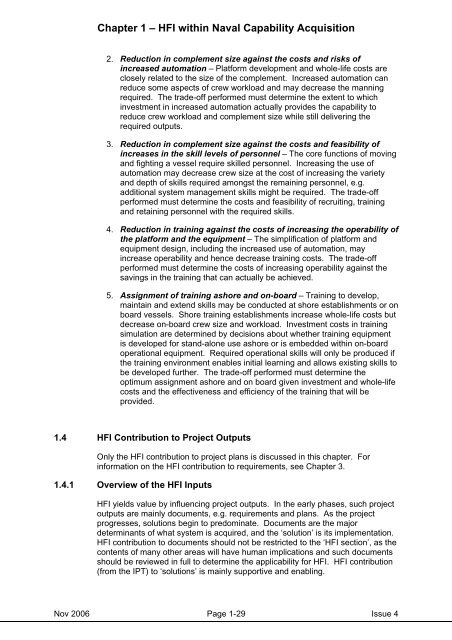MAP-01-010 HFI Management Guide - Human Factors Integration ...
MAP-01-010 HFI Management Guide - Human Factors Integration ...
MAP-01-010 HFI Management Guide - Human Factors Integration ...
You also want an ePaper? Increase the reach of your titles
YUMPU automatically turns print PDFs into web optimized ePapers that Google loves.
Chapter 1 – <strong>HFI</strong> within Naval Capability Acquisition<br />
2. Reduction in complement size against the costs and risks of<br />
increased automation – Platform development and whole-life costs are<br />
closely related to the size of the complement. Increased automation can<br />
reduce some aspects of crew workload and may decrease the manning<br />
required. The trade-off performed must determine the extent to which<br />
investment in increased automation actually provides the capability to<br />
reduce crew workload and complement size while still delivering the<br />
required outputs.<br />
3. Reduction in complement size against the costs and feasibility of<br />
increases in the skill levels of personnel – The core functions of moving<br />
and fighting a vessel require skilled personnel. Increasing the use of<br />
automation may decrease crew size at the cost of increasing the variety<br />
and depth of skills required amongst the remaining personnel, e.g.<br />
additional system management skills might be required. The trade-off<br />
performed must determine the costs and feasibility of recruiting, training<br />
and retaining personnel with the required skills.<br />
4. Reduction in training against the costs of increasing the operability of<br />
the platform and the equipment – The simplification of platform and<br />
equipment design, including the increased use of automation, may<br />
increase operability and hence decrease training costs. The trade-off<br />
performed must determine the costs of increasing operability against the<br />
savings in the training that can actually be achieved.<br />
5. Assignment of training ashore and on-board – Training to develop,<br />
maintain and extend skills may be conducted at shore establishments or on<br />
board vessels. Shore training establishments increase whole-life costs but<br />
decrease on-board crew size and workload. Investment costs in training<br />
simulation are determined by decisions about whether training equipment<br />
is developed for stand-alone use ashore or is embedded within on-board<br />
operational equipment. Required operational skills will only be produced if<br />
the training environment enables initial learning and allows existing skills to<br />
be developed further. The trade-off performed must determine the<br />
optimum assignment ashore and on board given investment and whole-life<br />
costs and the effectiveness and efficiency of the training that will be<br />
provided.<br />
1.4 <strong>HFI</strong> Contribution to Project Outputs<br />
Only the <strong>HFI</strong> contribution to project plans is discussed in this chapter. For<br />
information on the <strong>HFI</strong> contribution to requirements, see Chapter 3.<br />
1.4.1 Overview of the <strong>HFI</strong> Inputs<br />
<strong>HFI</strong> yields value by influencing project outputs. In the early phases, such project<br />
outputs are mainly documents, e.g. requirements and plans. As the project<br />
progresses, solutions begin to predominate. Documents are the major<br />
determinants of what system is acquired, and the ‘solution’ is its implementation.<br />
<strong>HFI</strong> contribution to documents should not be restricted to the ‘<strong>HFI</strong> section’, as the<br />
contents of many other areas will have human implications and such documents<br />
should be reviewed in full to determine the applicability for <strong>HFI</strong>. <strong>HFI</strong> contribution<br />
(from the IPT) to ‘solutions’ is mainly supportive and enabling.<br />
Nov 2006 Page 1-29 Issue 4
















